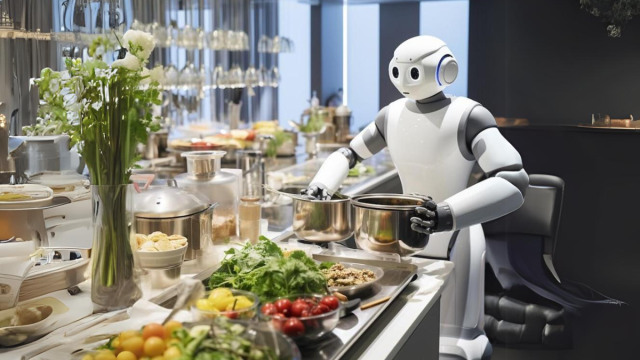Introduction
Contents
In the ever-evolving landscape of culinary arts, technology is playing an increasingly significant role. The spotlight at CES 2024 was firmly on robotic chefs and AI-powered kitchen gadgets, heralding a new era where humans might not need to cook themselves anymore. As labor shortages and the quest for efficiency drive innovation, robotic chefs are set to revolutionize the way we prepare and enjoy our meals. This article explores the exciting advancements in robotic cooking technology and their potential impact on the culinary world.
The Rise of Robotic Chefs
Efficiency and Consistency
One of the primary advantages of robot cook is their ability to provide increased efficiency and enhanced consistency. Unlike human cooks, robots do not need breaks and can perform repetitive tasks with unerring precision. This capability ensures that every dish is prepared to the same high standard, regardless of the time or kitchen workload.
For example, Flippy by Miso Robotics can cook up to 300 burgers an hour, consistently delivering perfectly cooked patties. Such efficiency not only speeds up service but also allows human chefs to focus on more intricate and creative aspects of cooking. This symbiotic relationship between humans and robots could lead to more innovative and refined culinary creations.
Advanced Capabilities
Robotic chefs are becoming increasingly sophisticated, thanks to advancements in machine learning and robotics. These improvements enable robots to handle more complex tasks, such as gently manipulating delicate ingredients or using various kitchen tools safely. New technologies in robotic arms and hands allow these machines to perform detailed tasks, like decorating cakes or making dumplings, with a level of finesse previously reserved for human hands.
Moreover, robotic chefs are expanding their repertoire to include a broader range of cuisines. Initially excelling in fast food preparation, these robots are now venturing into more diverse culinary territories, such as Chinese, Indian, and Thai cuisines, which require precise cooking techniques and flavor balancing. This expansion promises to bring the authentic flavors of international dishes to robotic kitchens worldwide.
Innovations at CES 2024
Cutting-Edge Gadgets
CES 2024 showcased a plethora of high-tech kitchen gadgets designed to make meal preparation easier and more enjoyable. Among the highlights was the Yo-Kai Express robot chef machine, developed in partnership with Pulmone, which captivated attendees with its culinary prowess. This robot can prepare a variety of dishes, demonstrating the potential for robotic chefs to handle complex meal preparations.
Another notable innovation was the Perfecta AI grill by Seer Grills, which uses AI to ensure perfectly cooked meals every time. These advancements highlight the growing trend of integrating AI and robotics into everyday kitchen appliances, making gourmet cooking accessible to everyone.
AI-Powered Appliances
The integration of AI into kitchen appliances was another significant trend at CES 2024. The Samsung Bespoke AI Family Hub refrigerator, for instance, showcased how AI can manage food storage and meal planning efficiently. These smart appliances are designed to assist with everything from ingredient management to recipe suggestions, reducing the need for overthinking in the kitchen.
Additionally, the Bartesian cocktail-mixing machine and Sweet Robo’s ice cream-making machine demonstrated how AI-powered devices could elevate the home dining experience by offering barista-quality drinks and desserts at the touch of a button. These gadgets exemplify the convenience and sophistication that AI can bring to home kitchens.
Benefits of Robotic Chefs
Improved Food Safety
Robotic chefs offer significant improvements in food safety. They are designed to be easy to clean and minimize the risk of contamination from human handling. Robots can also consistently monitor cooking temperatures and times, ensuring that food is cooked safely and reducing the chances of foodborne illnesses.
Cost Efficiency
While the initial investment in robotic chefs can be substantial, the long-term benefits often outweigh the costs. Robots can operate continuously without needing breaks, vacations, or healthcare, resulting in reduced labor costs for restaurants. This cost efficiency can be particularly beneficial in an industry often plagued by high turnover rates and staffing challenges.
Enhanced Creativity and Innovation
With robots handling repetitive and mundane tasks, human chefs are free to explore their creativity and innovate new dishes. This collaborative dynamic allows for a more vibrant and dynamic kitchen environment where the unique strengths of both humans and robots are utilized to their fullest potential.
Conclusion
The advent of robotic chefs marks a significant milestone in the evolution of kitchen technology. These innovations promise to transform the culinary landscape by offering enhanced efficiency, consistency, and food safety, while also providing opportunities for human chefs to focus on creativity and innovation. As robotic chefs continue to evolve, they will undoubtedly play a crucial role in shaping the future of food preparation, bringing us one step closer to a world where the art of cooking is seamlessly blended with cutting-edge technology.
The future kitchen will likely see a harmonious collaboration between humans and robots, each contributing their strengths to deliver exceptional culinary experiences. With robotic chefs taking care of the routine tasks, overthinking meal preparation will become a thing of the past, allowing us to enjoy the creative and delightful aspects of cooking and dining like never before.


